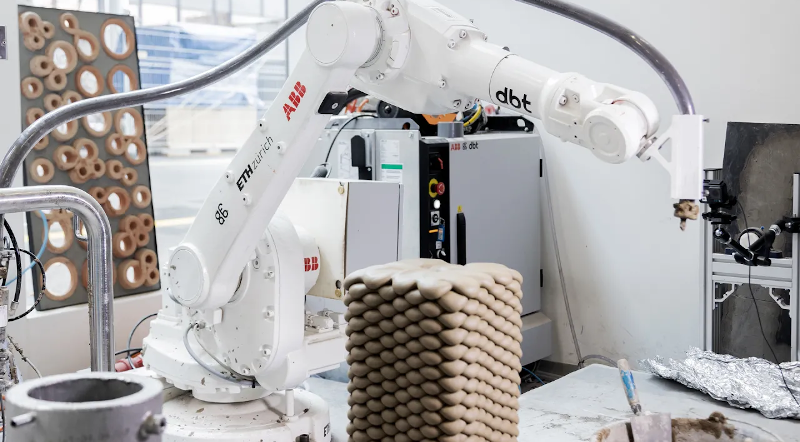The latest 3D printing application? Forming concrete. That’s according to a team at ETH Zurich who claims that construction with foam forms cuts concrete usage up to 70%. It also offers improved insulation properties. You can see a video about the process, below.
Typical concrete work relies on a form often made with wood, steel, or plastic. That’s easy to do, but hard to make complex shapes. However, if you can create complex shapes you can easily put material where it adds strength and omit material where it doesn’t carry load. Using a robotic-arm 3D print technique, the researchers can lay out prefabricated blocks of foam that create forms with highly complex shapes.
The foam elements go in a conventional wood form and are cast as usual with — in this case — high-performance fiber-reinforced concrete. The resulting structure is strong but lighter than a conventional concrete structure. The foam parts can be left in or removed at the end of the process.
The design required 12 different shapes and 24 individual elements. The 3D printing material is a type of mineral foam made from recycled materials.
We have seen 3D printing via robotic arm before. Of course, 3D printing structures is all the rage lately and we’ve seen it done with concrete many times.















Similar things have been done with wood formers for eons in rather complex and impressive shapes, and the forms are reusable/recyclable too… I’m really not sure the robot arm and ‘mineral foam’ (whatever that really is) make sense in this context unless you are leaving them in for better insulative properties…
Using such a concept with foam (recycled source or not – perhaps just hotwire cut relatively normal insulation sheets?) to put insulation in all the areas you can without compromising the structure/ designing such that the insulation is targeted at the areas that most need it is clearly a winner. But this feels like something I’d come up with despite it seeming like a pretty stupid idea just to justify playing with a robot arm…
p.s. that is more than enough reason to do such a thing, play is fun and just might lead to a more sensible looking idea down the line…
I have to agree that this is a very inefficient way of creating the negative space parts. It also makes little sense to bother scooping the parts out if you aren’t going to reuse them.
This is very efficient – in funneling scientific grant money, the sole purpose of this project.
Agree. My first thought was why not use a hot wire and cut foam shapes out of Styrofoam or other foam material. Or maybe use some sheet material to create the voids molds. Seems too easy?
Any possible uses for retaining walls?
I have a hunch that concrete isnt going to be able to take compressive loads very well. so… 1 or 2 stories at most?
And if it can take the same compressive load in one configuration, you know that it will be installed upside down where it can not.
This idea would be extremely easy to implement without 3d printing and without recycled materials (Eg hot wire foam). We must then ask ourselves, why is it that slabs are generally solid? Surely if they were better having voids, they would have voids.
Slabs are generally solid because it’s quick and easy and cheap and idiot-proof.
Are they generally solid though? I first read about hollow-core slabs in the eighties I think, and it seems to have caught on. (https://www.researchgate.net/profile/Tohid-Ghanbari-Ghazijahani/publication/295907804_Finite_element_modelling_of_hollow-core_concrete_slabs/links/56d0191008ae85c8234672af/Finite-element-modelling-of-hollow-core-concrete-slabs.pdf)
The slab seems solid though, as the infill is completely hidden.
On the foam part, I am curious about the density compared with the concrete it replaces.
What it has going for it is (likely) it’s nonflammable, polystyrene is horrible in that regard. Also, if it saves something going to the landfill, thumbs up.
This is obviously a PoC, but scaled up to industrial size with the printing directly in the form and concrete poured automatically, this could potentially enable resource saving one-off structures directly based on stress calculations.
With structural concrete it’s not just about immediate strength but also endurance over time. That includes keeping out the weather. I can’t see voids helping with that. Solid blocks please.
And as far as slabs, go stuff like this already exists: https://www.dezeen.com/2019/11/23/reduction-concrete-plastic-bubbles-enables-cobiax/
> Surely if they were better having voids, they would have voids.
Remember when we said that about reusable rockets? There are still plenty of opportunities to improve on how things are done.
Maybe make a giant concrete soda stream and carbonate the concrete. Less weight, at least a little, carbon capture and possibly slightly stronge, all be it with the increased risk of explosion upon heating.
You mean AAC?
https://en.m.wikipedia.org/wiki/Autoclaved_aerated_concrete
It’s basically being done already under the name Aircrete. You mix soapy water with concrete to make a super porous block.
Air entrained concrete is a thing.